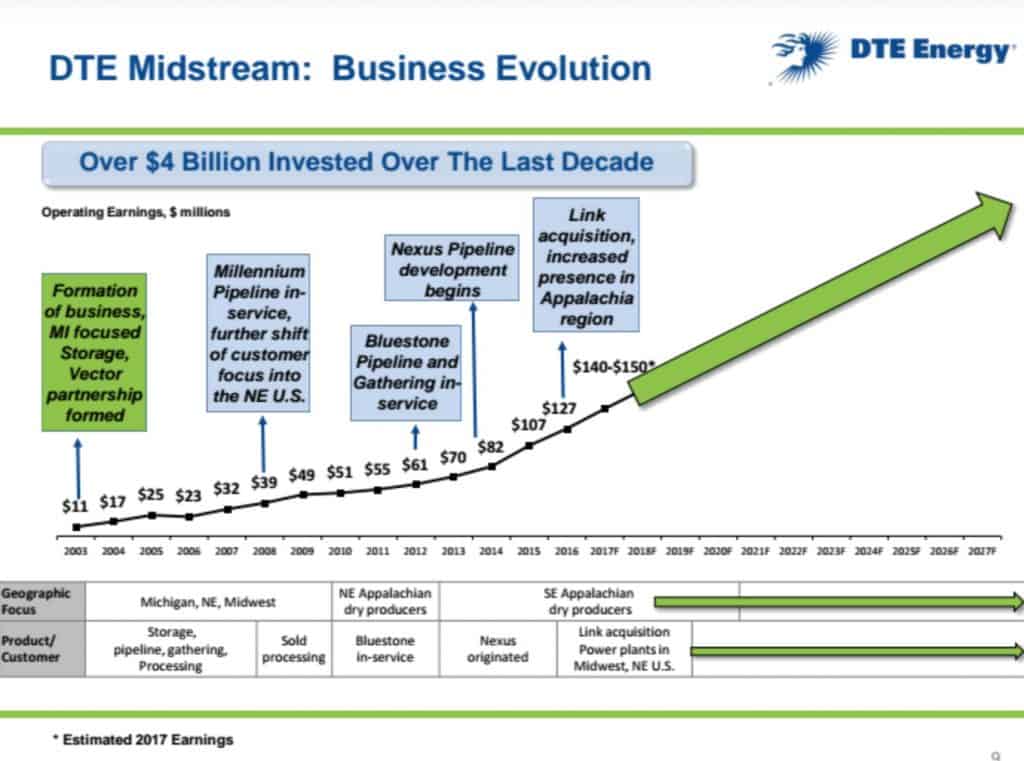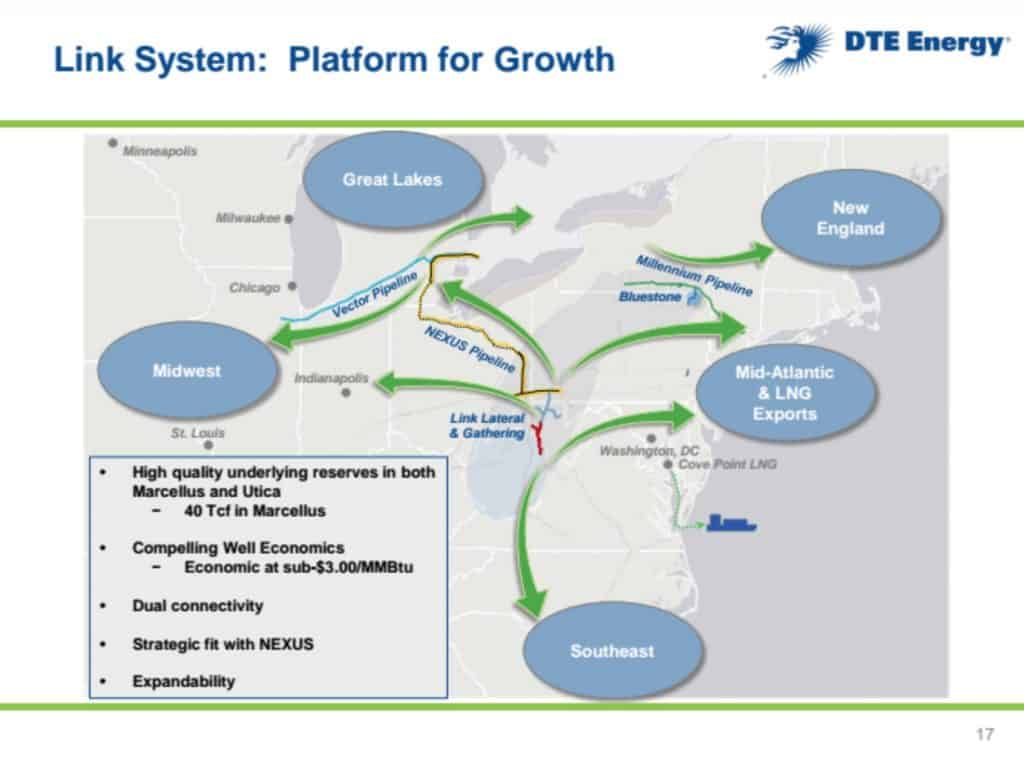Updated on September 10 with a response from DTE Energy
DTE Energy has been sharply criticized in recent weeks over its integrated resource plan filing, in which the company proposed further investment in gas plants rather than renewable energy and battery storage.
A coalition of renewable energy, environmental and consumer advocates called for the PSC to flat-out reject the utility’s long-term integrated resource plan (IRP) in joint testimony with the Michigan Public Service Commission on August 21. They called for DTE to refile it using a “modern tool that can simulate how the grid functions with today’s (and tomorrow’s) technology…”. The coalition detailed how the utility failed to recognize the declining costs of battery storage and renewable energy, underestimated the benefits of energy efficiency. They also explained how DTE’s choice to favor natural gas units over renewable energy and battery storage for ramping energy and capacity was a bad deal for customers.
“DTE’s plan favors its own expensive power plants over a truly robust process to ensure cleaner and more affordable energy for Michigan customers,” Union of Concerned Scientists Senior Energy Analyst with the Climate & Energy Joe Daniel wrote. “I’ve seen utility commissions reject resource plans for far less egregious missteps.”
The IRP process is not the only place where DTE has argued against renewable energy and battery storage.
Why so anti-storage? DTE’s affiliated gas investments offer clues
The company’s bias towards gas was briefly on display last month in a room full of state energy policy makers at the National Conference of State Legislators (NCSL), where DTE Energy’s Skiles Boyd, vice president of environmental management and resources, told conference attendees that the utility isn’t fully looking at battery storage because of where Michigan is situated:
“We’re in the North. We’re not talking about storage for a couple of hours to change a peak, we’re talking storage for three to four weeks. We don’t have that yet. I think natural gas is going to play a part for a good while to come. I think we need to push carbon capture and storage and other things, but [natural gas] is going to be there for a while.”
Boyd’s remarks at NCSL echo what DTE stated in the IRP docket:
“Q103. Will lithium-ion battery technology resources be recommended as a resource in DTE Electric’s proposed course of action?
A103. No. Currently, lithium-ion storage batteries and lithium-ion storage batteries and solar are uneconomical and limited in operational availability.”
In response, Solar Energy Industries Association’s Director of Rate Design Kevin Lucas said,
“This clearly flies in the face of announcements from all over the country related to the pending deployment of solar + storage resources by other vertically integrated utilities in the next 2-5 years … I have already shown that standalone storage competes against any other technology on an energy basis and is cheaper than an advanced CT on a capacity basis even when DTE owns the project.”
DTE’s gas investments and IRP filings stand in stark contrast with Michigan’s other large investor-owned utility – Consumers Energy, despite the fact that it obviously shares the same cold climate that Boyd offered as a rationale to legislators for DTE’s eschewing of storage. In an interview with Midwest Energy News, Consumers Energy CEO Patti Poppe said the company was initially prepared to file an IRP that included a proposal to construct natural gas power plants. However, the plan shifted to favor clean energy.
“Given that we have the opportunity of a generation to determine how we’ll replace these big central power plants, we’ll replace them with modular renewables because it’s smarter,” Poppe said.
The PSC approved Consumers Energy’s IRP in June. The utility says the approval will allow it to add 5,000 megawatts of solar energy through competitive bidding by 2030 and meet 90 percent of customers’ electricity capacity needs through energy efficiency, demand response, renewable energy and energy storage by 2040.
NIPSCO, based in similarly cold-climate Northern Indiana, told Indiana regulators that of all the pathways it analyzed, skipping gas in favor of renewable energy and storage was the one with the lowest cost for consumers.
The Energy and Policy Institute has detailed how DTE’s flawed decision-making in Michigan may be correlated to significant investments by another business segment to increase profits: the transportation of fracked natural gas from the Marcellus and Utica shale basins to power plants and gas distribution grids across the country. The company’s natural gas and pipelines business segment has contributed a total of $608 million in income towards the company’s overall earnings since 2017 through the first six months of 2019.
A 2017 presentation by DTE Energy Midstream executives revealed that this business segment invested $4 billion in infrastructure from 2007 to 2017, and set its sights on moving even more gas throughout the Midwest, New England, Mid-Atlantic, and Southeast. According to the company’s latest annual report to investors, DTE plans to spend between $4 and $5 billion over the 2019-2023 period on natural gas gathering and pipeline investment expansion.
The billions of dollars worth of current and planned fossil fuel infrastructure investments have likely affected DTE Energy’s ability to accurately value the benefits of renewable energy, energy efficiency, and battery storage.
State legislator questions DTE over methane emissions
At NCSL, DTE’s Boyd also dodged the critical issue of methane emissions from its pipelines segment. He also tried to minimize the threat that methane poses as a potent greenhouse gas.
During the question-and-answer session at NCSL, an Oregon state senator said he and other lawmakers were persuaded by the science behind methane’s contribution to the climate change problem. He also said that the issue isn’t being adequately addressed throughout the whole supply chain, specifically at the extraction and transportation level.
The state senator asked Boyd for “any comments you have on that or whether we can look forward to dramatic technological improvements to reduce methane contribution to the overall GHG.”
Boyd said, “We do recognize that is an issue and I would say the release may not be as great as some people think they are that have been published a lot here recently” (emphasis added).
Last year, a study published in the journal Science concluded that U.S. oil and gas operations are leaking 60 percent more methane than the EPA had previously calculated, which translates to 13 million tons more each year. Climate scientists have raised the alarm for years about methane emissions produced by shale gas from wellhead to delivery, since methane is an incredibly potent greenhouse gas. In 2009, a study by scientists at NASA and Columbia University estimated that methane’s global warming potential could be 79 to 105 times greater than CO2 over a 20-year time frame. But in the years since that study, natural gas has been touted as a “bridge fuel,” and utilities like DTE have incorporated it into their plans to combat global warming.
Boyd then said that DTE Gas has a goal of reducing methane emissions by 80% by 2040 through its distribution system, but admitted that it is “mainly through the replacement of gas mains” and “improvements in compressor maintenance.” DTE Gas is working to replace about 200 miles of natural gas distribution lines annually with a target to complete the goal of upgrading its system by 2035. The PSC has approved of DTE spending and recovering from ratepayers $169.7 million this year, and nearly $200 million annually from 2020 through 2023 on those upgrades.
Boyd never addressed his company’s interstate pipeline business, but he revealed that his new CEO, Jerry Norica, is chairing a new “sustainability” effort for the American Gas Association, Edison Electric Institute, and Interstate Natural Gas Association of America.
“My new CEO’s goal is he wants to be able to say, ‘I’m going to buy this gas, and I’m not going to buy that gas … It’s the five guys in the drilling rig that we have to work with and help them along with the whole process. Because we recognize that if we don’t fix the whole thing, we’re sunk to get where we need to get to.”
While Norcia attempts to create a sustainability effort within the gas industry so the company can continue to earn profits on its gas investments, the Trump administration recently announced its intentions to eliminate EPA rules that require the oil and gas industry to detect methane leaks from wells, pipelines and storage facilities, and then repair the infrastructure. The American Petroleum Institute applauded the rollback and told the New York Times, “We think it’s a smarter way of targeting methane emissions.”
September 10 Update: After EPI published this blog on September 3, DTE spokesperson Pete Ternes sent EPI the below comment, which EPI is publishing in full.
EPI additionally asked whether Skiles Boyd’s remarks were an accurate reflection of DTE’s position on battery storage. DTE did not respond.
EPI also asked whether DTE had a comment on why utilities such as Consumers Energy and NIPSCO do not seem to find their position in northern states to be a barrier to battery storage. DTE did not respond to that question either.
DTE Energy’s comment:
“To be clear, DTE is not requesting additional spending on natural gas in the IRP. DTE’s IRP includes-near term spending to more than double its renewable energy production over the next five years by investing ~$2.5 billion in wind and solar facilities. For the long term, the company presents four possible scenarios, two without additional gas facilities and two with – for discussion with the Michigan PSC and other interested parties.
DTE has also proposed various solar and storage pilots in the near term to improve understanding of how these technologies can be used to reliably serve customers’ energy needs. DTE’s longer term plans are purposely flexible to accommodate improvements in storage technology and costs.”
Featured image is NEXUS Pipeline. Source: Youtube



